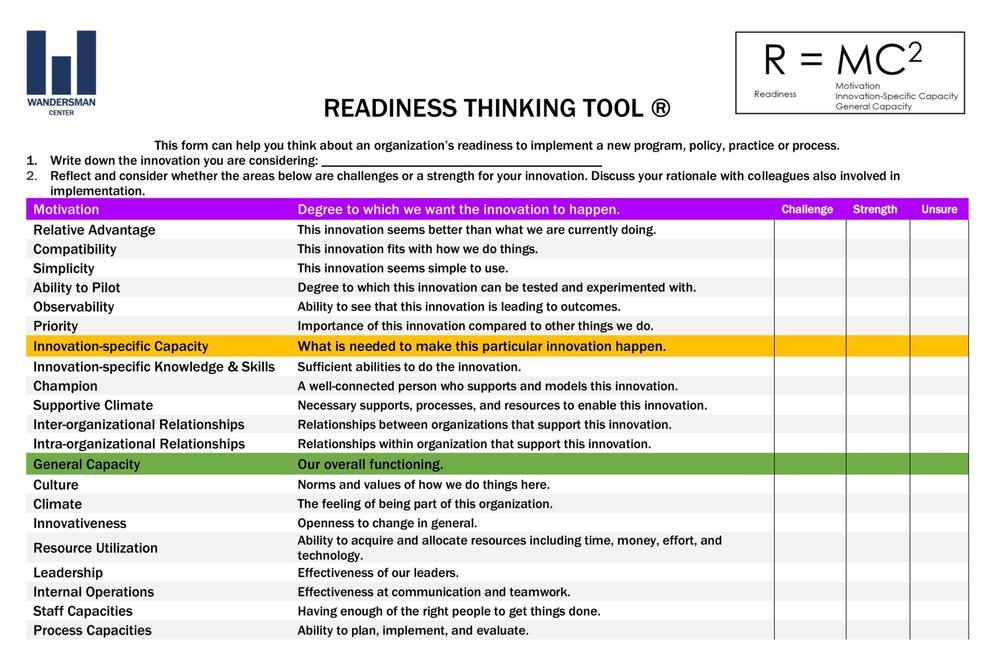Readiness Thinking Tool: Why Organizational Readiness for Change Matters
By Dr. Sobia Khan, Director of Implementation
Over the past decade, organizations have increasingly focused on the role that readiness plays in their implementation initiatives. This is likely because historically, innovations were rolled out in organizations without really paying attention to contextual factors that can influence adoption, implementation quality, and outcomes. The belief that an evidence-based innovation will work solely because of the existing evidence base is losing steam – we know that we need to implement evidence-based innovations in an amenable context at an amenable time. Organizational readiness for change assessments help us understand whether an organization is ready to receive an innovation at the crucial adoption stage, as well as throughout implementation and sustainability.
What is organizational readiness for change?
The best way to break down organizational readiness for change is by understanding individual readiness for change, which is where this concept is derived from. Imagine any change you have been trying to make in your own life – for example, deciding to commit to exercise at least three days a week. The evidence is clear: exercise is beneficial. You may need to consider your capacity to exercise 3 times a week: how much time you have each day, whether or not you have the right equipment or membership, your physicial ability to exercise in specific ways, your knowledge on how best to exercise. However, the biggest make or break factor is likely going to be how motivated you are to exercise (i.e., whether or not you are psychologically capable of making this commitment and sticking to it). This is the true difference between readiness for change and capacity for change.
Organizational readiness for change is much the same. However, since an organization is made up of multiple individuals, organizational readiness for change is the collective capacities and motivations for change. Not only do organizations require the right knowledge, infrastructure, equipment, etc. for change – the individuals in the organization have to be collectively motivated to make change happen. This is an important point to drive home, because too many organizations that I have worked with equate readiness with structural capacity for change, but not with the psychological capacity for change. Both components need to be understood and explored. To learn more about this distinction, check out this article by Holt and colleagues.
In this issue of Implementation in Action, Dr. Jonathan Scaccia, the Chief Operating Officer of the Wandersman Center, gives us a snapshot of the extensive work his organization has been doing in supporting organizational readiness assessments across the United States.
Readiness Thinking Tool
By Jonathan Scaccia, Chief Operating Officer, Wandersman Center
The Wandersman Center uses readiness and implementation science to help diverse stakeholders plan, implement, and evaluate with quality. As has been recognized, programs and policies must be implemented well to have a positive impact in a community. Through our teams’ collective decades of academic and practical work in program development, implementation science, and evaluation, we concluded that organizational readiness is key to the success of these initiatives. We compiled the key elements into an easy-to-remember heuristic (see this article for more details on the heuristic):
Readiness = Motivation x Innovation-Specific Capacity x General Capacity,
or
R = MC^2
Several principles of organizational readiness guide our work.
To understand readiness, we need to be much more granular about the specific aspects of motivation and capacity.
Organizations can have different “readinesses” for different innovations.
Readiness is not static and can be enhanced.
Readiness applies across multiple system levels (community, organizations, teams, individuals.)
Readiness matters throughout implementation, from startup through to sustainability.
Recently with support from the Robert Wood Johnson Foundation, we helped implement readiness-focused technical assistance with the Centers for Disease Control’s Office for Smoking and Health (CDC-OSH). We trained project officers to assess the three readiness components with their state grantees. While we used a specific tool, we learned what is more critical is how Readiness Thinking helps stakeholders develop a language to describe the contextual and implementation issues they are facing. Our team followed the assessment by developing readiness-specific technical assistance plans that targeted areas of weakness perceived as potentially problematic for implementation. The team and project officers then drew upon their experiences as technical assistance providers and the change management literature to develop strategies to improve readiness for tobacco-related policies.
This work matters because lower resourced settings do not implement as well as those with more resources. This pattern sets up a perpetuating cycle whereby poor implementation contributes to ongoing equity gaps. Across all our work, we try to find methods to help all organizations implement and reach outcomes in their communities. We see readiness as a practical model to facilitate this.
Download the Wandersman Readiness Thinking Tool.
These articles were featured in our monthly Implementation in Action bulletin! Want to receive our next issue? Subscribe here.
Are you looking for other tools? Check out:

